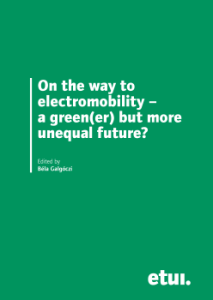 On the way to electromobility – a green(er) but more unequal future?
On the way to electromobility – a green(er) but more unequal future?
Chapter 7 – pages 241 – 264
John Szabo, András Deák, Andrea Szalavetz and Gábor Túry
The Hungarian automobile industry: towards an understanding of the transition to electromobility
As it becomes clearer and clearer that none of the 14 million jobs in the broad automobile industry will remain unaffected by the transition to e-mobility, less attention has been paid to what would happen if Europe’s car industry failed to keep pace with the global competition in fast-evolving zero emission technologies. A new book from ETUI reveals that further employment risks and growing inequalities may appear if European manufacturers continue to abandon the lower market segments of electric vehicles and leave these to foreign competitors.
For over a decade, Europe’s automotive manufacturers have prioritised a high end, low volume strategy to maximise profits. SUVs in Europe sell for almost 60 per cent more on average than an equivalent car and manufacturers appear to be culling small cars in the pursuit of profit. VW, Stellantis and BMW have all announced that they will not be changing their strategy with electric cars. This ongoing upmarket drift is undermining the broader shifts in mobility, especially given low investment in public transport and in integrated transport solutions. There is, consequently, a danger of movement towards a mobility that is class-based.
The chapters of this book entitled On the way to electromobility – a green(er) but more unequal future? reveal the depth of the changes taking place at national level as well as at that of the main manufacturers and suppliers in the context of fierce cost and technological competition. The study also provides a comparative overview of the main manufacturers and regions in Europe regarding the mostly generalist volume producers in France and Italy, the predominantly premium manufacturers in Germany and the integrated periphery in central and eastern Europe. While in the last twenty years manufacturers from all regions have seen a decrease in the number of cars sold, automotive employment has remained stable in Germany but seen deep losses in France and Italy.
Central and eastern Europe, the main beneficiary of the post-enlargement expansion of the automotive industry, is now facing an uncertain future. The region is vulnerable and dependent on decisions made in headquarters locations. While some countries see potential in keeping the combustion engine alive for longer – thereby risking long-term competitiveness – others are embracing the transition to e-mobility by embarking on strong supplier positions, for example in battery manufacturing.
The need for European smaller, affordable, entry-level electric cars
‘Regulators should ensure European small cars do not disappear. Incentives for building small electric vehicles should be provided based on industrial policy initiatives, local content provisions and public procurement rules. Subsidies for electric cars should support entry-level models “made in Europe”,’ recommend the authors of this new book. After a late start, the EU is now well placed in this rapid technology race, including in the battery value chain. Nevertheless, while automotive manufacturers make more profit on every SUV sold, the small car segment is where the volume is. If European producers concede this segment, models by BYD, Great Wall Motor and SAIC’s MG will take their place: most of the revenue from the small cars sold in Europe will thus have been generated in China. Failure to scale up the supply of battery electric vehicles within Europe could thus result in foreign manufacturers offering affordable models and capturing a large share of the mass market in Europe. And, with the mass market comes mass employment. If the EU is unable to regulate its own market efficiently, it risks losing economic sovereignty in the automotive industry.


